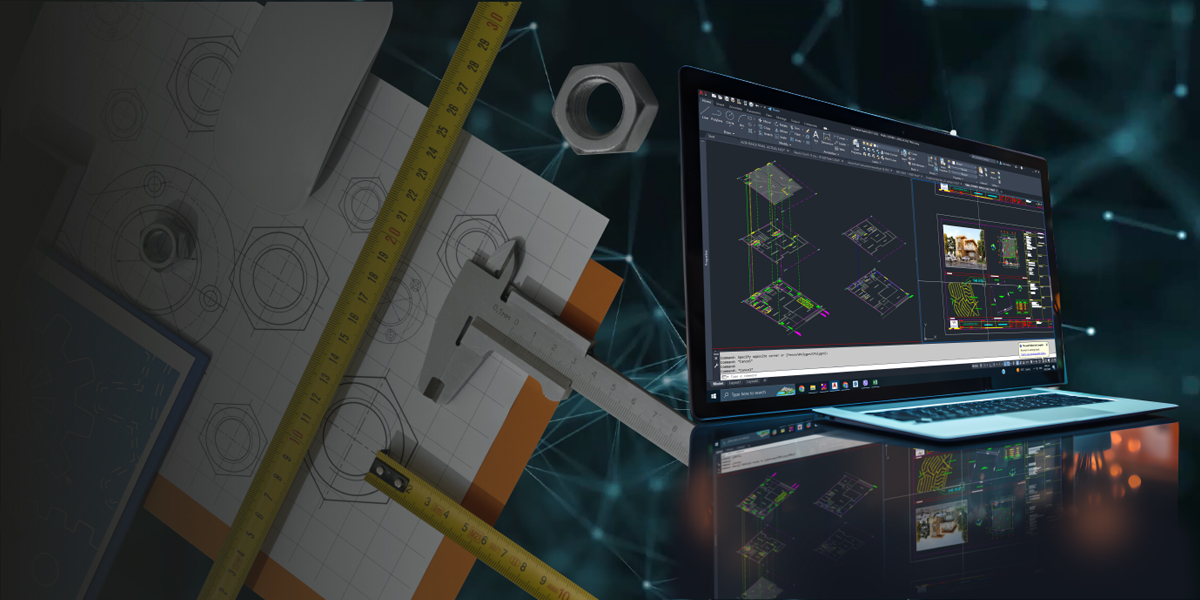Prior to the introduction of CAD, prototyping was comprised of the following phases:
- Idea
- Hand Drawn Sketch
- Hand Calculations
- Physical Prototype
- Testing
- Data Analysis
- Repeat steps 2-6….most likely several times
In today’s world, CAD and other significant technology improvements have changed the prototyping process. The “digital prototype” can provide significant cost savings by shortening the design cycle. This is done by creating models & drawings more efficiently, ruling out bad designs faster with built-in FEA capabilities and integrating with downstream systems, even machines themselves.
Embrace the Digital Prototyping Workflow
A digital transformation is happening, and companies are jumping on the bandwagon all across the globe. The new version of prototyping looks like this:
- Start with an Idea: Begin your design process in the digital realm, where modifications and iterations are both cost-effective and swift.
- Develop Digital Prototypes: Utilize CAD tools to bring your ideas to life, iterating quickly and efficiently in a virtual environment.
- Analyze Digitally: Employ built-in FEA capabilities to evaluate designs, making necessary adjustments long before the physical prototype stage.
- Repeat as Needed: The ease of iteration in the digital space means fewer cycles are needed to perfect your design.
- Proceed to Production: With digital prototyping, some projects can move directly from digital prototype to production, bypassing the physical prototype stage altogether.
Throughout the digital prototyping process, it’s important to document analysis results and track design & model changes as they occur. Managing these changes can be difficult without a solid data management tool in place that integrates well with your CAD software. From 1 person teams to 1000 person teams, good data management practices can help companies avoid costly mistakes and stay organized.
Best Practices for Digital Prototyping
When developing digital prototypes, here are some other best practices to keep in mind from a data management perspective:
- Don’t Cut Corners - This concept relates to many different areas of design and managing information. In this case, I’m referring specifically to important metadata that needs to be passed to downstream users. Things like part material (is it mild steel, aluminum, etc?), description, part number, project number, and dozens of other critical details often get overlooked during the early stages of concept development. Take the extra time to enter information as soon as you know it. It will save you headaches later on. There are many ways to make these steps mandatory also if your team tends to forget them.
- Collaboration Leads to Better Designs - Whether it’s a Design Review meeting with the Engineering Manager, bouncing an idea off of a Welder in the shop, or relaying details to an outside contractor, collaborating almost always leads to better designs. PDM & PLM tools normally have ways to facilitate these types of interactions without having to track down other people. Automated workflows and free viewers allow for easily connecting with upstream/downstream peers to review designs together and make informed decisions on feature changes.
- Document Everything - This is the age of information and there’s never a shortage of data to track, especially in the product design industry. I’m not just talking about metadata, I’m talking about the “why” and “how” we do things. As we go through the product development process, lessons learned need to be documented to not only improve the design in question, but future designs also. The more information gathered, the easier it is to create standards for your company and train everyone involved how to do things the right way.
- Don’t be Afraid to Do it Your Way - There are certain concepts that have become industry standards, like managing revisions, lifecycles, engineering changes, etc. Just because they are commonly accepted as good practices, doesn’t mean the “out of the box” methods need to be adapted letter for letter by your company. Each company is unique and certain workflows may work for one company but not the other. The beauty of most PDM/PLM tools is that they can be customized to meet your company's needs. We’ve all heard the “square peg in a round hole” phrase…so don’t let systems drive your company's decisions. Try to figure out what your target workflow is and then see if it’s attainable. Compromise may be required at some point, but don’t feel like you can’t explore options first.
Embracing Digital Design
The evolution from traditional methods to digital prototyping represents a significant shift in the landscape of product development, emphasizing efficiency, cost reduction, and the opening of new frontiers for innovation. This shift is not merely about adopting new technologies but is a testament to the transformative power of integrating digital tools into the creative process. Digital prototyping, with its emphasis on rapid iteration and detailed analysis, underscores the critical role of robust data management and the adoption of modern methodologies in achieving streamlined design processes and enhanced product outcomes.
As we navigate this digital design revolution, the principles of collaboration, adaptability, and a commitment to innovation guide our approach. The digital era beckons us to rethink traditional boundaries and embrace the potential for unprecedented levels of productivity and creativity. By leveraging the capabilities of digital prototyping tools and adhering to best practices in data management, companies are positioned to not only thrive in the current technological landscape but also to shape the future of design and product development.
Reserve Your Spot Now
Learn more about PDM software like Autodesk Vault and see it in action this Thursday (February 22) @ 11 a.m. ET.

